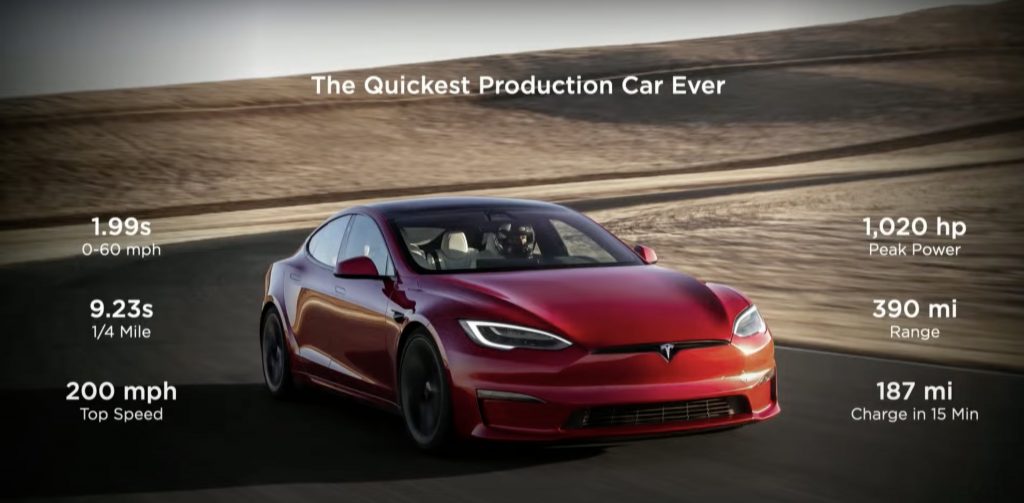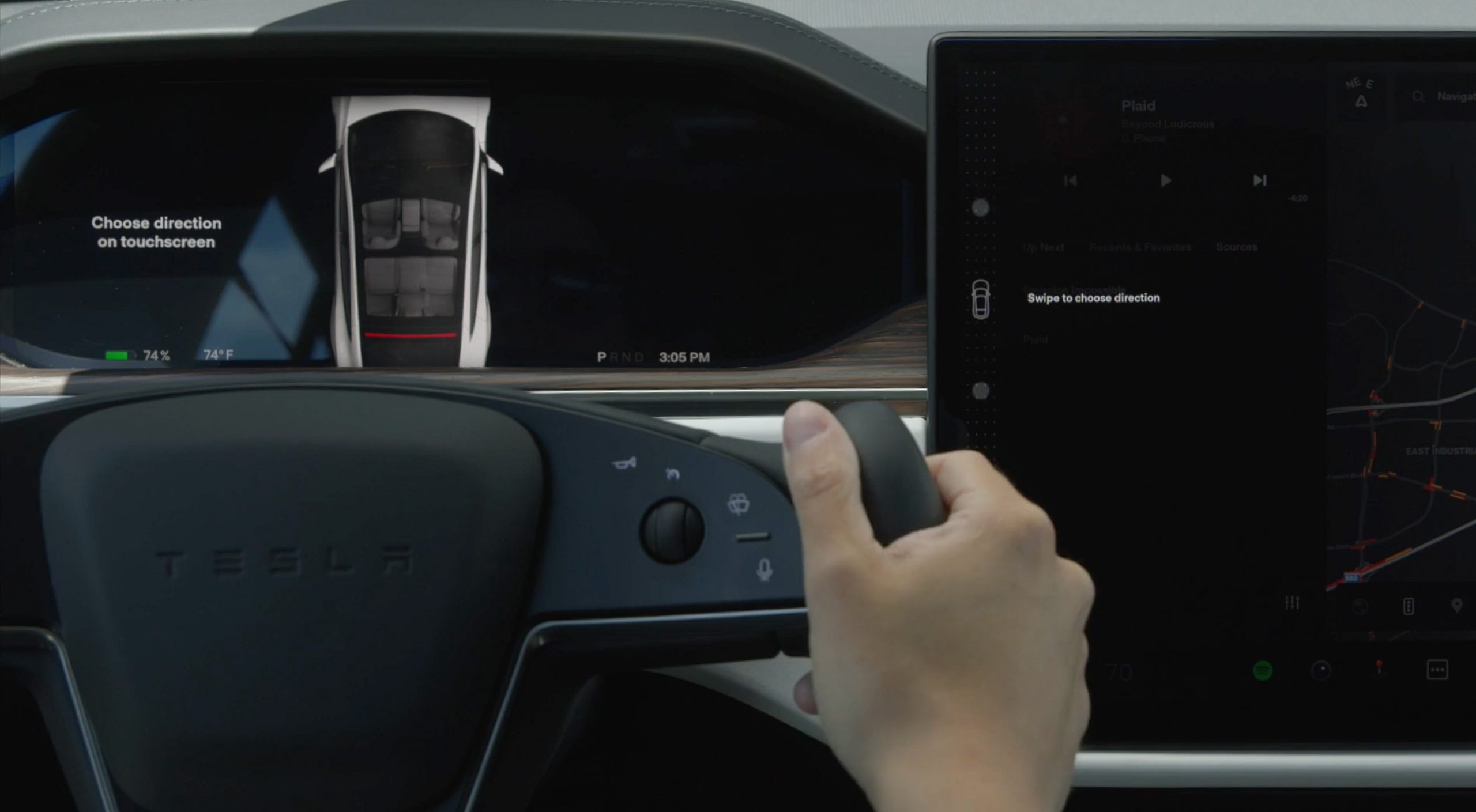“I think generally all input is error,” said Tesla CEO Elon Musk when he explained the Model S Plaid’s Auto Shift feature. Tesla removed the stalks when reinventing the Tesla Model S Plaid’s design. “If you have to do something that the car could have done already, that should be taken care of; the software should just do it,” Musk remarked.
This approach was evident in the Model S Plaid’s Auto Shift feature, which uses software to determine if the vehicle should be in Drive, Park, Neutral, or Reverse. The new Tesla Model S manual goes further into detail about Auto Shift and the vehicle’s gears.
Touchscreen Gear Shift
For drivers who would still prefer shifting gears manually, the new Model S has a gear strip available on the car’s touchscreen under “Controls.” The gear strip will be displayed on the left side of the touchscreen when a driver presses the brake pedal while parked.
- Drive – Swipe up on the gear strip on the touchscreen. Drivers can only shift into “D” when the Model S is stopped or moving less than 5 mph or 8 km/h in Reverse.
- Reverse – Swipe down on the gear strip. Drivers can only shift into “R” when the Model S is stopped or moving less than 5 mph or 8 km/h in Drive. Drivers can manually close the park assist view on the touchscreen by touching the “X” in the upper corner.
- Neutral: To shift into Neutral, drivers should touch the “Controls,” then press and hold the Neutral icon until the Model S engages the “N” gear. When the Model S is traveling over 5 mph or 8 km/h and swipes up or down on the gear strip, a Neutral icon will appear at the top of the gear strip that drivers can engage.
Model S Park
The Park button is only displayed when the brake pedal is pressed. Shifting into Park is allowed when the vehicle’s driving speed is less than 5 mph or 8km/h.
The Model S will automatically shift to Park when it observes signs that drivers are about to exit the vehicle, like when the driver unbuckles his/her seat belt and the car is stopped. Other instances the Model S will shift into Park would be when the driver’s door is open or the vehicle hasn’t moved within one minute of shifting into Drive gear.
Auto Shift Out of Park
Auto Shift Out of Park allows the Model S to shift out of Park on its own, providing more convenience. In the Model S owner’s manual, Tesla notes that Auto Shift out of Park is a BETA feature and is disabled by default.
“When Auto Shift out of Park is enabled, Model S is designed to use inputs from various sensors to automatically select a driving gear when you are ready to drive. The selected gear is displayed on the instrument panel when the driver’s door is closed, and the seatbelt is buckled,” said the manual.
Drivers can override the selected gear by pressing the brake pedal, then use the touchscreen to choose the gear they prefer. Drivers must always press the brake pedal to shift out of Park.
Tesla cautions drivers to follow the instructions on the panel before pressing on the accelerator after confirming their gear selection. The Model S will not shift out of Park if it is still plugged into a charging port.

Model S in Drive Gear
The Model S automatically selects the driving gear when the following conditions are met:
- Auto Shift out of Park is enabled (touch Controls > Pedals & Steering > Auto Shift out of Park).
- The vehicle is in Park.
- The driver’s seat belt is fastened.
- The brake pedal is pressed.
- All doors and trunks are closed.
- The gear selector on the center console is not activated.
Emergency Gear Shift Controls
Drivers can use the gear selector on the center console in the unlikely event that the touchscreen is unavailable and the gear shift is unaccessible. The letters “P,” “R,” “N,” and “D” are displayed in the center console and can be activated when pressed. The frunk, trunk, and doors must be closed to select a gear in the center console.
Tesla notes that the gear selector in the center console activates when the touchscreen is unavailable or the Model S in Valet or Transport Mode. Otherwise, drivers must press the letter buttons to activate the gear selector.
“If you try to shift into a gear that the current driving speed prohibits, the instrument panel displays an alert, a chime sounds, and the gear does not change,” Tesla states in the manual.
As a side note, Tesla stated that drivers could also activate the gear selector by briefly pressing the scroll buttons on the yoke steering wheel simultaneously. Holding the scroll buttons for a longer time would activate the gear selector in the center console and restart the touchscreen as well.
Model S Owners Manual North America en Us by Maria Merano on Scribd
The Teslarati team would appreciate hearing from you. If you have any tips, email us at tips@teslarati.com or reach out to me at maria@teslarati.com.
News
Tesla launches in India with Model Y, showing pricing will be biggest challenge
Tesla finally got its Model Y launched in India, but it will surely come at a price for consumers.

Tesla has officially launched in India following years of delays, as it brought its Model Y to the market for the first time on Tuesday.
However, the launch showed that pricing is going to be its biggest challenge. The all-electric Model Y is priced significantly higher than in other major markets in which Tesla operates.
On Tuesday, Tesla’s Model Y went up for sale for 59,89,000 rupees for the Rear-Wheel Drive configuration, while the Long Range Rear-Wheel Drive was priced at 67,89,000.
This equates to $69,686 for the RWD and $78,994 for the Long Range RWD, a substantial markup compared to what these cars sell for in the United States.
🚨 Here’s the difference in price for the Tesla Model Y in the U.S. compared to India.
🚨 59,89,000 is $69,686
🚨 67,89,000 is $78,994 pic.twitter.com/7EUzyWLcED— TESLARATI (@Teslarati) July 15, 2025
Deliveries are currently scheduled for the third quarter, and it will be interesting to see how many units they can sell in the market at this price point.
The price includes tariffs and additional fees that are applied by the Indian government, which has aimed to work with foreign automakers to come to terms on lower duties that increase vehicle cost.
Tesla Model Y seen testing under wraps in India ahead of launch
There is a chance that these duties will be removed, which would create a more stable and affordable pricing model for Tesla in the future. President Trump and Indian Prime Minister Narendra Modi continue to iron out those details.
Maharashtra Chief Minister Devendra Fadnavis said to reporters outside the company’s new outlet in the region (via Reuters):
“In the future, we wish to see R&D and manufacturing done in India, and I am sure at an appropriate stage, Tesla will think about it.”
It appears to be eerily similar to the same “game of chicken” Tesla played with Indian government officials for the past few years. Tesla has always wanted to enter India, but was unable to do so due to these import duties.
India wanted Tesla to commit to building a Gigafactory in the country, but Tesla wanted to test demand first.
It seems this could be that demand test, and the duties are going to have a significant impact on what demand will actually be.
Elon Musk
Tesla ups Robotaxi fare price to another comical figure with service area expansion
Tesla upped its fare price for a Robotaxi ride from $4.20 to, you guessed it, $6.90.

Tesla has upped its fare price for the Robotaxi platform in Austin for the first time since its launch on June 22. The increase came on the same day that Tesla expanded its Service Area for the Robotaxi ride-hailing service, offering rides to a broader portion of the city.
The price is up from $4.20, a figure that many Tesla fans will find amusing, considering CEO Elon Musk has used that number, as well as ’69,’ as a light-hearted attempt at comedy over the past several years.
Musk confirmed yesterday that Tesla would up the price per ride from that $4.20 point to $6.90. Are we really surprised that is what the company decided on, as the expansion of the Service Area also took effect on Monday?
But the price is now a princely $6.90, as foretold in the prophecy 😂
— Elon Musk (@elonmusk) July 14, 2025
The Service Area expansion was also somewhat of a joke too, especially considering the shape of the new region where the driverless service can travel.
I wrote yesterday about how it might be funny, but in reality, it is more of a message to competitors that Tesla can expand in Austin wherever it wants at any time.
Tesla’s Robotaxi expansion wasn’t a joke, it was a warning to competitors
It was only a matter of time before the Robotaxi platform would subject riders to a higher, flat fee for a ride. This is primarily due to two reasons: the size of the access program is increasing, and, more importantly, the service area is expanding in size.
Tesla has already surpassed Waymo in Austin in terms of its service area, which is roughly five square miles larger. Waymo launched driverless rides to the public back in March, while Tesla’s just became available to a small group in June. Tesla has already expanded it, allowing new members to hail a ride from a driverless Model Y nearly every day.
The Robotaxi app is also becoming more robust as Tesla is adding new features with updates. It has already been updated on two occasions, with the most recent improvements being rolled out yesterday.
Tesla updates Robotaxi app with several big changes, including wider service area
News
Tesla Model Y and Model 3 dominate U.S. EV sales despite headwinds
Tesla’s two mainstream vehicles accounted for more than 40% of all EVs sold in the United States in Q2 2025.

Tesla’s Model Y and Model 3 remained the top-selling electric vehicles in the U.S. during Q2 2025, even as the broader EV market dipped 6.3% year-over-year.
The Model Y logged 86,120 units sold, followed by the Model 3 at 48,803. This means that Tesla’s two mainstream vehicles accounted for 43% of all EVs sold in the United States during the second quarter, as per data from Cox Automotive.
Tesla leads amid tax credit uncertainty and a tough first half
Tesla’s performance in Q2 is notable given a series of hurdles earlier in the year. The company temporarily paused Model Y deliveries in Q1 as it transitioned to the production of the new Model Y, and its retail presence was hit by protests and vandalism tied to political backlash against CEO Elon Musk. The fallout carried into Q2, yet Tesla’s two mass-market vehicles still outsold the next eight EVs combined.
Q2 marked just the third-ever YoY decline in quarterly EV sales, totaling 310,839 units. Electric vehicle sales, however, were still up 4.9% from Q1 and reached a record 607,089 units in the first half of 2025. Analysts also expect a surge in Q3 as buyers rush to qualify for federal EV tax credits before they expire on October 1, Cox Automotive noted in a post.
Legacy rivals gain ground, but Tesla holds its commanding lead
General Motors more than doubled its EV volume in the first half of 2025, selling over 78,000 units and boosting its EV market share to 12.9%. Chevrolet became the second-best-selling EV brand, pushing GM past Ford and Hyundai. Tesla, however, still retained a commanding 44.7% electric vehicle market share despite a 12% drop in in Q2 revenue, following a decline of almost 9% in Q1.
Incentives reached record highs in Q2, averaging 14.8% of transaction prices, roughly $8,500 per vehicle. As government support winds down, the used EV market is also gaining momentum, with over 100,000 used EVs sold in Q2.
Q2 2025 Kelley Blue Book EV Sales Report by Simon Alvarez on Scribd
-

 News3 days ago
News3 days agoTesla debuts hands-free Grok AI with update 2025.26: What you need to know
-

 Elon Musk1 week ago
Elon Musk1 week agoElon Musk confirms Grok 4 launch on July 9 with livestream event
-

 Elon Musk5 days ago
Elon Musk5 days agoxAI launches Grok 4 with new $300/month SuperGrok Heavy subscription
-

 News2 weeks ago
News2 weeks agoTesla Model 3 ranks as the safest new car in Europe for 2025, per Euro NCAP tests
-

 Elon Musk2 weeks ago
Elon Musk2 weeks agoxAI’s Memphis data center receives air permit despite community criticism
-

 News5 days ago
News5 days agoTesla begins Robotaxi certification push in Arizona: report
-

 Elon Musk2 weeks ago
Elon Musk2 weeks agoTesla reveals it is using AI to make factories more sustainable: here’s how
-

 Elon Musk2 weeks ago
Elon Musk2 weeks agoTesla scrambles after Musk sidekick exit, CEO takes over sales














